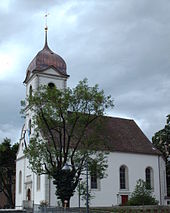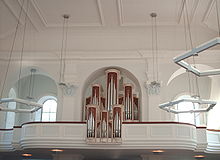Reformed Church Baden
The Reformed Church of Baden is today the central church of the Reformed parish of Baden in Switzerland , which, with its parishes of Baden- Ennetbaden , Ehrendingen - Freienwil , Obersiggenthal and Untersiggenthal, forms the largest parish of the Reformed Church in Aargau . When the baroque church was built at the beginning of the 18th century, however, there was no Reformed community in the city of Baden. It was a provocation for the Catholic population.
history
During the Second Villmerger War , Catholic Baden was besieged in 1712 by troops from the Reformed towns of Bern and Zurich . The Stein Fortress , which had been built four decades earlier , failed to defend the city against artillery fire from the people of Zurich, whereupon Baden had to surrender due to the severe damage in the city.
The winners allowed the population of Baden to remain Catholic, but stipulated in the peace treaty that the city must provide a church room for Reformed worship services. The Verena chapel on offer turned out to be too small. Therefore, it was on the adjacent hospital lawn, at the Badstrasse between the city and the bathing quarter a new church built. The stones for the construction came from the razed fortress Stein, the construction timber had to be delivered free of charge by the city of Baden.
The church was completed in time for the Baden Peace Congress to resolve the War of the Spanish Succession . On July 1, 1714, Pastor Johann Jakob Wolf from Zurich gave the first sermon. The spacious new church did not have its own congregation, as there was no free settlement for Reformed people in Baden. The only Reformed people in the village were bailiffs and land clerks with families and servants who came from the Reformed towns of Bern , Zurich and Glarus , Reformed members of the Diet, the garrison and the Reformed pastor whom the people of Baden had to accept by order of Zurich. The numerous bathers from Zurich were also among the church visitors.
In the middle of the 18th century, two Reformed farming families came to the Baden suburb of Dättwil and formed the beginning of a local Reformed community. Only with the general freedom of settlement in 1798 was it possible for Reformed people to settle in the city of Baden, and the Reformed community was able to develop. In 1793 the German philosopher Johann Gottlieb Fichte and Johanna Rahn were married in the church , and fifty years later that of the German poet Georg Herwegh with Emma Herwegh (at which the Russian anarchist Michail Bakunin was also present).
Until 1798, the owners of the collature were Zurich and Bern, which initially alternately appointed a preacher every Sunday, but later introduced several years of office. In 1803 the newly founded canton of Aargau came into the possession of the benefice . In 1861 the church property came into the possession of the parish, five years later the parish could also elect the pastor independently.
In 2011 Swiss television broadcast all four Reformed services from this church.
building
The building, which has been a listed building since 1947, is a symmetrical, baroque hall church . Their length (27.4 meters) and their width (16.6 meters) are in proportion to the golden ratio , as are the width of the hall and the height of the roof (10.1 meters). The 32 meter high church tower is integrated into the front facade, its ground floor forms a common hall with the church. Due to its location, the entrance is in the east and the choir in the west, in contrast to the usual orientation of churches.
From 2003 to 2007 the church was completely renovated inside and outside by the architects Miroslav Sik, Zurich.
The reformed, simple sermon hall offers space for 250 people. In order to enable a wide range of uses, it was divided into four areas during the renovation: the slightly raised choir, opposite rows of benches with a free central area, the traditional rows of benches with a central aisle separated by a cross and a spacious meeting area at the entrance.
During the renovation, the two side entrances removed in the 1940s and the wall paneling removed at the time were restored. The interior is based on the original colors from 1714 in the original white, with pale blue capitals as the only decoration on the walls. The ceiling is stucco as it was before . Four modern pentagonal chandeliers are new , which allow different lighting depending on the use.
In the choir there is a modern, altar-like unit made of wood and aluminum with a lectern in the middle, baptismal font on the left and communion table on the right, in the free central room is a lecturer's desk made of the same material. The two-manual organ dates from 1965.
literature
- Otto Mittler : History of the City of Baden . Volume II: From 1650 to the present . Sauerländer, Aarau 1965, p. 76-81 .
- Peter Hoegger: The art monuments of the canton of Aargau . Ed .: Society for Swiss Art History . Volume VI: District Baden I . Birkhäuser Verlag, Basel 1976, ISBN 3-7643-0782-X , p. 200-213 .
Web links
- Reformed parish of Baden
- Reformed Church Baden in the inventory of historical monuments of the canton Aargau
Individual evidence
- ↑ Why the Reformed Church in Baden is becoming a TV star , Aargauer Zeitung , July 7, 2010
Coordinates: 47 ° 28 '35.6 " N , 8 ° 18' 32.9" E ; CH1903: 665,620 / two hundred fifty-eight thousand seven hundred eighty-three




